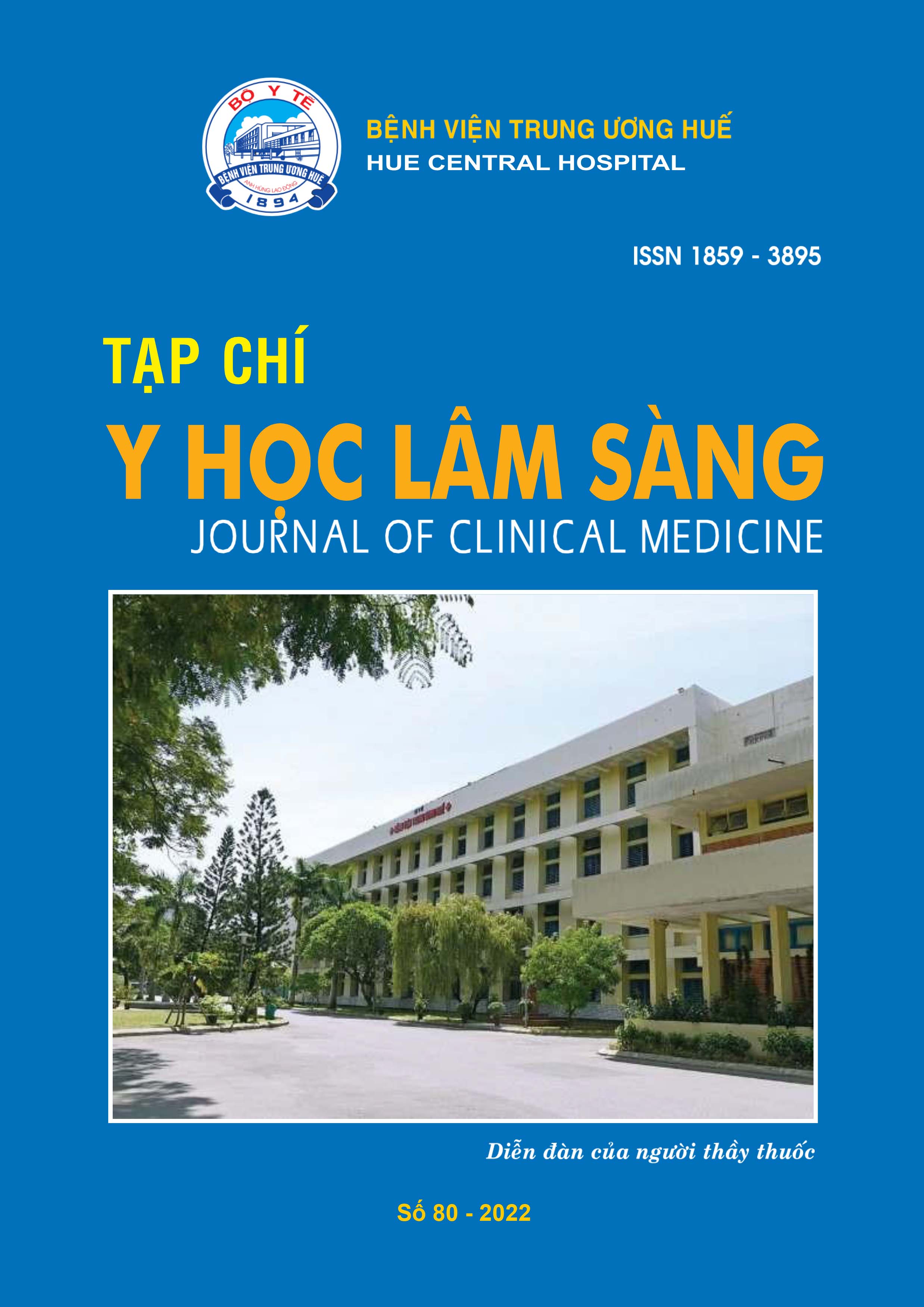Abstract
Purpose: Evaluation result ofultrasound - guidem mini - percutaneous nephrolithotipsy on patients in lateral position at Hue university of medicine and pharmacy Hospital.
Methods: A total of 38 patients with kidney stones treated ultrasound - guidem mini - percutaneous nephrolithotipsy on patients in lateral position at Hue university of medicine and pharmacy Hospital between April 2019 and September 2021.
Results: Mean age is 46.5 ± 11.2 years old (17 - 76). Gender: male 20 (52.6%), female 18 (47.4%). The renal stones were located at different sites: simple caliceal stones in 14 cases (36.8%); combined pelvic and one caliceal stonein 4 cases (10.6%) and scattered stones with multiple caliceal in 20 cases (52.6%). Pre - operative hydronephrosis cases detected by multi - slice computer tomography (MSCT): no hydronephrosis in 4 cases (10.5%); Grade I 16 cases (42.1%); Grade II 15 cases (39.5%); Grade III 3 cases (7.9%). Median stone size 256mm2 (56.55 - 582). Access to the upper calices was performed in 5 cases (13,2%), the middle calyx in 13 cases (34,2%) and the lower calices in 20 cases (52,6%). Mean operative time was 114.61 ± 31.55 min (45 - 180). Intra - operative complications included 3 cases (7,9%) of which there were 2 cases of pyelonephritis and stone fragments after dispersing along the tear outside the renal pelvis and 1 case had slipped sheath during surgery. Post - operative complications: 3 cases of fever in 7,4% cases, 1 case of haemorrhage requiring blood transfusion in 2,6%. Recorded 3 cases of using C-arm support during the puncture process in 7,9% cases. The mean length of hospital stay was 7,37 ± 1,618 day (5 - 16). Nephrostomy tube was removed 2 - 5 days after the operation 2,26 ± 0,554 day (1 - 3). Follow - up examination and double J stent removal was performed on 249 post - operative patients 01 month after the surgery with a stone - free rate of 34,2%.
Conclusion: Ultrasound - guidem mini - percutaneous nephrolithotipsy on patients in lateral position is a method that is highly beneficial for the patients, and less complications. However, this method still has certain limitations.
References
Patel SR, Nakada SY. The modern history and evolution of percutaneous nephrolithotomy. Journal of Endourology Case Reports. 2015;29:153-157.
Vano NJK, Duran A, Romano - Miller M, Rehani MM. Radiation - associated lens opacities in catheterization personnel: results of a survey and direct assessments. Journal of Vascular and Interventional Radiology. 2013;24:197-204.
Hidajat PW, Kreuschner M, Felix R, Schröder RJ. Radiation risks for the radiologist performing transjugular intrahepatic portosystemic shunt (TIPS). British Journal of Radiology. 2006;79:483-486.
Kumari PK, Wadhwa P, Aron M, Gupta NP, Dogra PN. Radiation exposure to the patient and operating room personnel during percutaneous nephrolithotomy,. International Urology and Nephrology. 2006;38:207-210.
Majidpour HS. Risk of radiation exposure during PCNL. Urology Journal. 2010;7:87-89.
Agarwal AM, Jaiswal A, Kumar D, Yadav H, Lavania P,. Safety and efficacy of ultrasonography as an adjunct to fluoroscopy for renal access in percutaneous nephrolithotomy (PCNL). BJU Int. 2011:108:1346-1349
Faulkner K, Vañó E. Deterministic effects in interventional radiology. Radiation Protection Dosimetry. 2001;94:95–98.
Linet DMF, Mohan AK et al,. Incidence of haematopoietic malignancies in US radiologic technologists. Occupational and Environmental Medicine. 2005;62:861-867.
Wenzl TB. Increased brain cancer risk in physicians with high radiation exposure. Radiology. 2005;235:709-711.
Tzou DT, Usawachintachit M, Taguchi K, Chi T. Ultrasound Use in Urinary Stones: Adapting Old Technology for a Modern - Day Disease. J Endourol. 2017;31:S89-s94.
Armas - Phan M, Tzou DT, Bayne DB, Wiener SV, Stoller ML, Chi T. Ultrasound guidance can be used safely for renal tract dilatation during percutaneous nephrolithotomy. BJU Int. 2020;125:284-291.
Sfoungaristos S, Gofrit ON, Pode D, Landau EH, Duvdevani M. Percutaneous nephrolithotomy for staghorn stones: Which nomogram can better predict postoperative outcomes? World J Urol. 2016;34:1163-8.
Türk C, Knoll T, Petrik A, Sarica K, Straub M, Seitz C, Guidelines on Urolithiasis. 2014: European Association of Urology
Mousavi - Bahar SH, Mehrabi S, Moslemi MK. Percutaneous nephrolithotomy complications in 671 consecutive patients: a single - center experience. Urol J. 2011;8:271-6.
| Published | 29-12-2024 | |
| Fulltext |
|
|
| Language |
|
|
| Issue | No. 80 (2022) | |
| Section | Original article | |
| DOI | 10.38103/jcmhch.80.16 | |
| Keywords | Sỏi thận, Tán sỏi thận qua da đường hầm nhỏ, hướng dẫn dưới siêu âm và tư thế bệnh nhân nằm nghiêng Renal stone, Mini - Percutaneous Nephrolithotripsy, Ultrasound - Guided and Patients in lateral position |

This work is licensed under a Creative Commons Attribution-NonCommercial-NoDerivatives 4.0 International License.
Copyright (c) 2022 Journal of Clinical Medicine Hue Central Hospital

